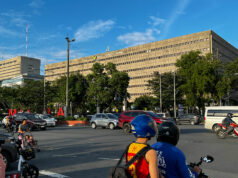Official inflation target kept at 2-4% till 2022
By Karl Angelo N. Vidal, Reporter
STATE ECONOMIC MANAGERS are keeping their 2-4% inflation target until 2022, as the overall increase in prices of widely used goods is expected to moderate further.
In a central bank statement sent late Thursday, the Development Budget Coordination Committee (DBCC), in coordination with the Bangko Sentral ng Pilipinas (BSP), said the target was set through DBCC Resolution No. 2019-1 dated Feb. 26.
The DBCC said the 2-4% target band approved by the government continues to be an “appropriate quantitative representation” of the medium-term goal of price stability.
“The BSP’s latest inflation projections indicate that inflation is likely to return to the target range over the medium term as the impact of supply-side shocks dissipate,” the statement read.
“Likewise, inflation expectations have stabilized and are seen to decline in 2019-2020.”
The central bank expects inflation to ease to 3.1% this year, well within the target band, from the a 5.2% average in 2018.
Inflation hit a nine-year-high 6.7% in September and October but has been easing since, hitting 4.4% in January.
The BSP said on Thursday that it expects February inflation, which the Philippine Statistics Authority will report on March 5, to have slowed further to 3.7-4.5%. February last year saw inflation clock in at 3.8%.
“Improved productive capacity of the economy, fueled by higher infrastructure investments by the national government, supports achieving robust economic growth amid a low and stable inflation environment,” the BSP said in its statement, noting that the recent inflation surge had been driven “largely by transitory supply-side factors” which the Executive branch had moved to address in September.
BSP Assistant Governor Francisco G. Dakila, Jr. had said after the Monetary Board’s policy meeting on Feb. 7 that inflation is now expected to return to below four percent by this month.
“Non-monetary measures have also been deployed by the NG to address supply shocks directly in the short run and the structural problems in the food/agriculture industry in the long run,” the DBCC added.
The rice tariffication law signed by President Rodrigo R. Duterte on Feb. 14 liberalizes importation of the staple by replacing quantitative restrictions on rice imports with tariffs: 35% for rice coming from within the Association of Southeast Asian Nations (ASEAN); 40% for imports within the 350,000 metric-ton minimum access volume (MAV), regardless of country; and 180% for above-MAV imports from non-ASEAN countries.
The relaxed rules on rice importation, which take effect on March 5, are expected to cut retail prices of the staple by up to P7 per kilogram and inflation by 0.7-0.8 percentage point.
Sought for comment, Union Bank of the Philippines, Inc. Chief Economist Ruben Carlo O. Asuncion said the decision to maintain the 2-4% inflation target range until 2022 may have stemmed from the longer-term prospects of global oil production.
“2019 may pose more price volatility, especially this first half of the year, but H2 (second half of the year) and potentially the next three years see a surge in global oil production coupled by the surprisingly resilient US shale oil production,” Mr. Asuncion said in an e-mail.
“[W]ith expected lower longer-term oil prices, local headline inflation consequently and most probably will be within the government’s inflation target.”
Rizal Commercial Banking Corp. economist Michael L. Ricafort said the government’s non-monetary measures to combat inflation “give further affirmation to the possible attainment of the 2-4% inflation target” up to 2022.



